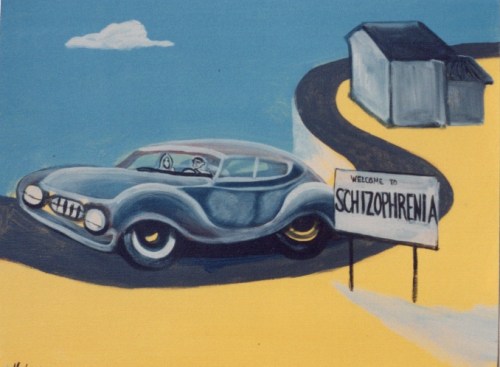| Home
More. . .
|
|
 |
TREATMENT
In treating Catatonic Schizophrenia one must realize that there are no known cures. But on the bright side there are many ways to treat this disorder and bring relief for the patient. The best treatment as thus far for Catatonic Schizophrenia is a combination of both medication and therapy.
There are two major types of antipsychotic medications available. They are known as traditional antipsychotic and new antipsychotic medications. The traditional medications include such drugs as melleril, haldol, and trilophon. These different medications may help the patient manage delusions and hallucinations, which are often quite hard to control. Side effects for all of these drugs are common and almost unavoidable and include dry mouth, constipation, dizziness, muscle cramps, facial ticks, panting, and pacing. These side effects are mild considering the wonders they work.
Probably the most popular type of treatment for catatonic schizophrenia is called Electroconvulsive Therapy or ECT. This type of treatment is actually only permitted in the United States and Great Britain for patients with severe catatonic excitement or stupor. For people who suffer from catatonic schizophrenia, ECT is generally set at being done three times a week. Depending on the patient, he might need from three to fifteen treatments to feel a major difference in behavior. First, the patient is put to sleep using barbiturate and succinycholine. After the patient’s muscles are relaxed, electrodes are placed on the forehead and just above the temple. A tiny current is then passed through the brain to cause a seizure. This current is only applied for a second and during this time the patient only breathes pure oxygen. The patient has a seizure from thirty seconds to a minute and wakes up after about fifteen minutes. The only side effects are right after the patient awakes including a drop in blood pressure, higher heart rate, and temporary memory loss. One of the main reasons that Electroconvulsive Therapy is used for patients with catatonic schizophrenia is because it keeps the patient from having relapses which takes away a great deal of stress for the patients and their family.
|
Who's Our Subject?
Charlene Manson is a 27 year old woman who works as a financial consultant for a top investment firm. Other than that, she's ordinary in every way. She has a great family and friends social network, and enjoys her job.
After she graduated from college, "Charle" was diagnosed with catatonic schizophrenia. With increasing pressure on her through her job, Charle fell victim to the diathesis-stress model. Because her great-grandmother had schizophrenia, but was never diagnosed for such, Charle had a genetic predisoposition to the disease, and its onset was caused by a late night in the office.
Charle did receive help, from Dr. Mando, and was prescribed a regiment of medications and electroconvulsive shock therapy. Her life was becoming normal again...that is, until she stopped both her medication and therapy. Her case of catatonic schizophrenia developed fully until she ran away, fearful that the mafia was after her. |
CAUSES
Schizophrenia is seen commonly throughout families. Parents with schizophrenia and the severity of their disorder influence the likelihood of their child having schizophrenia. The more severe the parents are the greater the likelihood of the child having it. You don’t inherit schizophrenia from your parents though nor do you inherit a predisposition for schizophrenia. What you do inherit is a general predisposition for schizophrenia that manifests in the same form or differently from your parents. Multiple genes are involved in creating a predisposition in developing the disorder and it is not yet determined how this genetic predisposition is transmitted.
Another cause that has been found in studies of people with schizophrenia is abnormalities in the brain structure. These abnormalities that were found were very subtle and not characteristic of all people with schizophrenia and they are not found to occur in every individual with schizophrenia. Microscopic studies have been done in the brains of people with schizophrenia after their death and it has been shown there are small changes in the distribution or number of brain cells in people with schizophrenia. Many of these differences are present before the person becomes ill and schizophrenia might be, partly, a disorder in development of the brain.
One of the most reliable observations of the brain is the size of the ventricles in the brain of people with schizophrenia. These cavities show enlargement in some but not all the brains of people who have the disorder. The size of the ventricles might not be as much of the problem as is the actual enlargement of the ventricles that shows that adjacent parts of the brain have not yet fully developed. |
DEFINITION
Schizophrenia according to the Diagnostic and Statistical Manual of Mental Disorders is “a disorder that lasts for at least 6 months and includes at least 1 month of active-phase symptoms (i.e., two [or more] of the following: delusions, hallucinations, disorganized speech, grossly disorganized or catatonic behavior, negative symptoms).” There are 4 subtypes of Schizophrenia, Paranoid, Disorganized, Catatonic, Undifferentiated, and Residual. (American Psychiatric Association, 298)
Our presentation and paper focus on Catatonic Schizophrenia. The behaviors for this are decrease reactivity to the environment, at times reaching a full unawareness, rigid and bizarre postures and resisting efforts to be removed, and unreasonable excess motor activity (APA, 300). Other behaviors of Catatonic Schizophrenia are too much or not enough motor movements, extreme negativism, mutism, echolalia, or echopraxia. Echolalia is when a person repeats everything another person says and echopraxia is when a person imitates the movements of another (APA, 315). To diagnose this disorder, a person must have at least 2 of the prior conditions.
Schizophrenia is a psychotic disorder. It is a disabling disorder that fortunately is relatively rare. It is supposedly rare because of the success of neuroleptic medications (Barlow & Durand, 429). Victims of Catatonic Schizophrenia have trouble controlling body movements and what they say. They will repeat the actions and words of others. They also become completely unaware of their environment at times. As you can see in our presentation, this disorder not only affects the person with schizophrenia but also the people in their lives.
Questions about the group or project?
|

www.artistsfriend.com/mlocke/ html/gallery51.html
|
|
|


